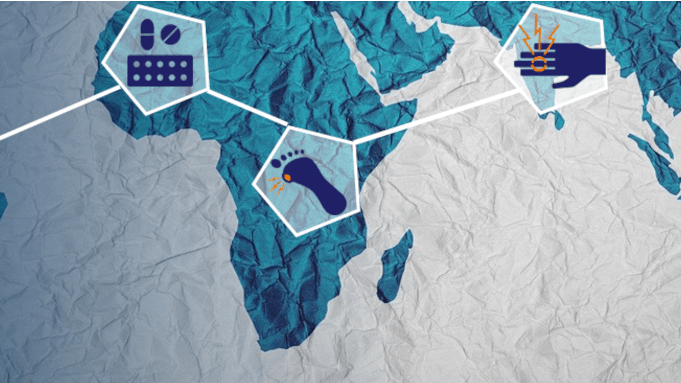Author: Claire Barnard
Challenges, guidelines, and research priorities
Psoriatic arthritis (PsA), a heterogeneous disease involving multiple domains, can be challenging to manage, particularly in resource-limited settings. With the majority of published research studies in PsA coming from resource-rich countries, guidelines from organizations including the European League Against Rheumatism (EULAR), the American College of Rheumatology (ACR), and the Group for Research and Assessment of Psoriasis and Psoriatic Arthritis (GRAPPA) are not necessarily applicable to clinical practice in places such as Africa and Latin America, and do not address the unique challenges faced by rheumatologists and other healthcare providers (HCPs) caring for people with PsA in these resource-limited settings.
In early 2020, the International League of Associations for Rheumatology (ILAR) issued some recommendations for PsA management in resource-limited settings based on an adaptation of existing guidelines from GRAPPA and EULAR. The authors highlighted a dearth of evidence to address a number of clinically relevant questions, and proposed research priorities for these settings.
We speak to Vinod Chandran (University of Toronto, Ontario, Canada), lead author on the ILAR guidelines, to gain an understanding of the present issues, and explore some of the particular considerations in specific settings through conversations with specialists who have experience working with PsA patients in Latin America, India, and Africa. Broadly, the issues fall into four main categories:
- access to specialists;
- treatment availability;
- monitoring considerations; and
- comorbidities.
We also talk to the specialists about the ILAR guidelines, and the current and future research priorities in the different settings.
The issues: Access to specialists
“Resource is always limited wherever you go worldwide,” and this is “particularly acute in otherwise resource-poor settings,” says Chandran. He points out that delayed diagnosis represents an important issue, arising because PsA requires expert assessment, but there are relatively few rheumatologists in some resource-limited settings compared with other HCPs such as primary care physicians and internal medicine specialists.
“A lack of awareness of this condition” in some settings means that “diagnosis is either not made or made too late and so the outcomes are then poor,” he adds.
Lack of facilities
Ashish Mathew, a rheumatologist who is currently based at the University of Toronto and previously worked at the Christian Medical College in Vellore, India, says that from a patient’s perspective, “the major resource limitations [in India] would be facilities and finances.” He explains that India has “no system of general practitioners or family physicians,” and patients make appointments directly with a rheumatologist when they experience symptoms, with a wait of around 2–3 months in large centers.
“The Christian Medical College is one of the biggest tertiary care centers in the country, and we have patients coming from different parts of India,” with “a specific derm–rheum combined clinic once a week where we see patients with psoriasis and psoriatic arthritis,” he says.
Mathew adds that rheumatologist availability is limited, with an urban–rural divide; he estimates that there are less than 1000 trained rheumatologists for the Indian population of 1.3 billion, with fewer and fewer specialists as you go from cities to more rural areas. This results in other specialists treating rheumatology patients in some instances, with some patients visiting orthopedic surgeons in the first instance “because they are considered to be the musculoskeletal doctors.”
Delayed referral
Penélope Palominos, a rheumatologist from Hospital de Clínicas de Porto Alegre in Brazil, says that access to care is also an issue in Latin America.
“Brazil is a country with very heterogeneous realities; in some cities the patients have difficulties to get a visit with a primary care physician and in other cities people have access to public university hospitals with a high level of excellence in health care,” she says.
Palominos explains that in many cities, “there is a long interval between the referral from the primary care physician until the first visit with [a] rheumatologist,” and “there are still few programs aiming to capacitate the primary care physician to recognize early arthritis.”
Furthermore, she notes that patients “who should be followed in primary care units,” such as those with osteoarthritis, fibromyalgia, and mechanical back pain, “are erroneously referred to tertiary care,” which reduces the availability of rheumatologists for patients with PsA and other types of inflammatory arthritis. Indeed, Palominos points to research from her team presented at the 2015 Brazilian Congress of Rheumatology showing that among 80 patients who were referred to a rheumatologist and received a diagnosis, 86.2% did not have inflammatory arthritis and were referred in error, highlighting the need for additional training among primary care providers.
Palominos says that limited availability of diagnostic technology in Brazil can also lead to delays in diagnosing PsA. She gives the example of spine magnetic resonance imaging (MRI), which “can help physicians to differentiate active PsA from mechanical causes of lumbar pain,” but which Palominos points out “takes more than 1 year to obtain” in her hospital, making this method of diagnosis infeasible.
Shortage of rheumatologists
Discussing the situation in Africa is Ajesh Maharaj, a rheumatologist from Westville Hospital in Durban, South Africa.
“There is a gross shortage of rheumatologists in South Africa,” he says, with “some provinces in the country that don’t even have a rheumatologist.”
“So that becomes a major issue in terms of waiting periods […] and therefore primary care physicians have to take the responsibility of making an early diagnosis and instituting appropriate therapy in these circumstances.”
Listen to Ajesh Maharaj talking about the shortage of rheumatologists in South Africa in more detail
The issues: Treatment availability
Chandran says that following delayed diagnosis, access to treatment can represent a major problem for some patients with PsA in resource-limited settings.
“The [conventional] DMARDs methotrexate, sulfasalazine, [and] leflunomide are the most commonly used drugs [in many resource-limited settings],” even though “the evidence of efficacy in PsA is not that great.”
He adds that “when it comes to biologics, even the biosimilars that are available in many parts of the world are still quite expensive, and so access to biologics is almost impossible in the average patient from resource-poor settings.”
Our interviewees from South America, India, and Africa all agreed that access to treatment, particularly biologics, is a problem in these settings.
Treatment delays
In Brazil, Penélope Palominos says that although a number of conventional DMARDs including methotrexate, sulfasalazine, cyclosporine, and leflunomide, as well as biologics such as tumor necrosis factor (TNF) inhibitors and interleukin (IL)-17A inhibitors, “are currently available in the public health system for treatment of PsA, there is a delay between the physician’s prescription and the patient’s receipt of the treatment.”
She points to a study published in 2019 showing that the median delay between the medical appointment and first dispensation of the prescribed drug for PsA was 66 days, with the largest delay due to “state proceedings, which include [the time between] requesting the drug until the authorization of treatments.”
“Patients with low educational and economic levels have difficulties obtaining all the documents required by the state and renewing the process every 6 months to receive their therapy,” she adds.
She notes that delays “in distributing the medicines from the capital to the smaller cities” in Brazil can contribute to problems with treatment access, with one study showing that limited drug access precluded treatment escalation in 18% of 78 patients who required escalation because they did not meet their treatment target of minimal disease activity.
Limited access to biologics
Ashish Mathew says that access to treatment is also a major limitation for managing PsA in India.
“Although I would really want to start my patients on biologic DMARDs given the broad spectrum of their actions” on the different domains of PsA, including the skin, the joints, enthesitis, dactylitis, and nails, in reality there is only a “very small proportion of patients who have access to biologic DMARDs when it comes to their financial status,” he remarks.
Most of the time we are “dependent on methotrexate, leflunomide, and sulfasalazine, and sadly enough, we don’t have much data in terms of patient care with these conventional DMARDs,” so “that’s kind of a limitation of what we work under,” says Mathew.
Furthermore, he stresses that even for those who can afford biologics, “the choices are limited,” because “there is a mix of originators and intended copies, [and] not real biosimilar drugs.”
Disparities in access to biologics
Ajesh Maharaj says that there are huge disparities in terms of biologic access in South Africa.
“South Africa has a unique healthcare system with a vast difference in the private healthcare system and the public healthcare system,” he comments.
In the private system, he says that “biologic therapies are quite available for patients who do not respond to conventional disease modifying agents, and treatment algorithms that are drawn up in Europe and America are somewhat followed,” whereas in the public system, “they do not have the luxury of freely available biologic therapy and in most instances, they are not available at all.”
And in other African countries, Maharaj notes that “there is a lack of biologic therapy in general,” because it “is extremely expensive, and not freely available, to most of the countries in Africa.”
In line with the situation in India as described by Ashish Mathew, Maharaj says that in general, “patients [in Africa] are treated very aggressively with conventional disease modifying agents, with the hope to attain low disease activity, or even remission,” but escalation to biologic therapy is not an option for many patients.
The issues: Drug monitoring
Chandran says that the monitoring associated with drug treatment in PsA can be a problem too.
“Access to the drugs continues to be a problem, and when we [have patients] on these drugs we tend to request blood tests to monitor for toxicity, especially in the first few months, [but] lack of access to testing facilities, cost, and even the reliability of these labs are a problem,” he explains.
“So once in management, even using drugs that have been available for many years is a problem when you treat patients in resource-poor settings.”
The issues: Comorbidities
Another factor that can complicate the diagnosis and management of PsA in resource-limited settings is the presence of comorbidities.
“These comorbidities will be different in different parts of the world,” says Chandran.
Indeed, Penélope Palominos highlights that “in Brazil some regions have high prevalence of tuberculosis, Chagas disease, leishmaniosis, [and] leprosy,” and “the use of immunosuppressive therapy in regions where infectious diseases are prevalent is a challenge.”
On the other hand, Ashish Mathew says that India is currently in a “transitional phase” regarding comorbidities.
“There was a phase which was troubled with communicable diseases; there were a lot of infections [such as] tuberculosis and leprosy,” but nowadays “we’re battling with another whole set of comorbidities that are similar to [those in] the Western world, [such as] cardiovascular diseases [and] noncommunicable diseases, including diabetes,” he explains.
“India is supposed to be the world capital of diabetes.”
The ILAR guidelines
In an attempt to address some of the issues with managing PsA in resource-limited settings, particularly the Americas and Africa, Chandran and colleagues developed the ILAR guidelines, which were adapted from existing recommendations from GRAPPA and EULAR.
“The idea was to try to focus on data coming out from these countries, so that we can give more specific recommendations tailored to them, so based on data, rather than expert opinion,” he says.
“But unfortunately, given the lack of personnel, resources, and the huge clinical burden, there is really not much research coming out of these settings, so despite our extensive systematic review, focusing on databases from Africa and Latin America, we really didn’t get answers to our questions,” he said.
Therefore, Chandran and team’s guidelines were “based mostly on expert opinion,” and focus on principles such as treatment goals, which “would be similar wherever you are in the world” – involving treatment targets of remission or minimal disease activity, and the need to assess all the domains of PsA – as well as “shared decision making and managing appropriate follow up based on what is practical in that setting.
It's about one rheumatologist to every one million people
Vinod Chandran Tweet
Chandran feels that “one of the criticisms [of the guidelines] would be that the recommendations don’t really tell you much [in addition to] what is already known.” However, “by putting [the topic] front and center, we’ve reminded everybody that this is an important disease to manage and there are unique problems in Africa and Latin America, primarily related to the access to therapy and associated infections and other comorbidities,” he says.
And Chandran believes that the most important outcome from the ILAR guidelines was a research agenda for resource-limited settings, “which hopefully will inspire people working in these areas to conduct studies […] so that these guidelines in future [can draw on] data from resource-poor settings, rather than just recommendations from [people who] have worked or are working in these areas.”
The research agenda
Chandran says that the research agenda for resource-limited settings includes many different avenues. Given the limited availability of rheumatologists in many countries, he thinks that one of the priorities should “be to try to evaluate patients treated by specialists versus internists [or] other general practitioners and see if their long-term outcomes are any different.”
Other important questions include “how frequently should we monitor?” and “how cost-effective is screening?” as well as the most appropriate combination therapy to use in countries with limited choice, he says.
Patients in resource-limited settings are often given “methotrexate [in combination with] leflunomide, methotrexate with sulfasalazine, [but] such combination therapy has not been really tested in clinical trials, and the safety is not really well known,” he says.
“People tend to borrow data from rheumatoid arthritis, [including on] management or combination therapies [and] standard of care, and we need to do more [studies] in psoriatic disease, especially in countries where the prevalence of infections and comorbidities is high, especially in diabetes and liver dysfunction.”
And in light of the comorbidity profile in many resource-limited settings, he says that further work is needed to establish how to screen for infections, as well as to learn how the treatment of these infections impacts PsA and vice versa.
“These questions have come to the forefront in Europe and North America because of COVID-19,” but “similar questions have always existed in resource-poor settings where there’s a lot of exposure to infections that we generally don’t see here in North America,” he stresses.
Infections, epidemiology, and treatment responses
Ajesh Maharaj says that better understanding of the interplay between PsA and infections, particularly HIV, is a key research priority in Africa.
“It is known that once patients with PsA develop HIV, the disease becomes worse,” but it is not known why, he says. “We need more research; the research agenda [in Africa] needs to be extended to HIV and PsA, rather than looking at these two different diseases in isolation.”
Maharaj believes that another key research priority in Africa is epidemiology. “We desperately need epidemiological studies in South Africa in particular and in Africa in general,” he stresses. Maharaj notes that there is a dearth of such studies in Africa, which could be partially attributed to a very low prevalence of psoriasis and PsA in the African population, the reasons for which are “not clearly understood and [have] not been studied previously.” This low prevalence could be due to genetics, he speculates, and believes it is important to investigate “whether these African populations have either the presence of a preventative gene, or a lack of susceptibility genes.”
And finally, Maharaj says that an important research question in the African setting is: “what are the local responses to available therapy and how do they differ from the responses in patients overseas?”
“I think these are very, very important research priorities that need to be put in place, and […] we need to take this research agenda forward in collaboration with our colleagues in Europe and in North America.”
Epidemiology and optimizing therapy
Epidemiologic studies – highlighted as a priority for Africa – are also top of the research agenda in India.
Ashish Mathew says “we definitely need data in terms of epidemiology,” but “a huge challenge [with conducting such studies] is funding and time, because on a regular day, rheumatologists would be seeing 40 to 50 patients.”
“So if you really look at the workload, research comes pretty low in the hierarchy, and there are few of us who drive to try and do as much as we can.” He explains that research funding is available for noncommunicable diseases in India, but rheumatology “comes lower in the list in terms of funding.”
Nonetheless, Mathew says that he is in the process of setting up a PsA registry – the Vellore Inception Psoriatic diseasE Registry (VIPER) – in collaboration with Philip Conaghan, from the University of Leeds in the UK, in order to collect data on the epidemiology of the disease in India. He stresses that data from combined clinics involving both dermatologists and rheumatologists “should be a priority,” given that a large number of patients are treated at such clinics in India.
In terms of drug studies, Mathew notes that “we need to experiment with combination therapy,” because biologics are unaffordable for most patients, and those who can afford to take them can only do so for a short period of time. He explains that for those who can afford some biologic treatment, “we advocate a 6-month period of biologic, [as] that’s the maximum they can afford.”
“A 6-month period of biologic, on average would cost around 100,000 Rupees [US$ 1330; € 1164], but most of these patients would be earning about 15,000–20,000 Rupees [$ 200–266; € 175–234] per month.”
He says that after an initial 6-month period, “we ask them to stop, or phase [the biologic] out, depending on how much they can afford at that point,” and “then try and combine with conventional DMARDs.” However, he notes that this strategy “is not really documented anywhere,” and requires further research to establish the best approach.
Mathew notes that research on methotrexate monotherapy is also needed, given that “when you’re in a situation where you don’t have any choice but methotrexate, it’s kind of your first line go-to drug.”
He remarks that one study conducted at Nizam’s Institute of Medical Sciences in Hyderabad, India, found that among PsA patients treated with methotrexate at a dose of at least 15 mg/week (average 17.5 mg/week), with targeted escalation every 4–12 weeks, approximately 60% achieved minimal disease activity (MDA), providing some support for this approach. However, “I think we need more data in terms of methotrexate,” he says.
And Mathew thinks that defining the most appropriate treatment target is another important avenue of research in the Indian setting.
“Treat-to-target, MDA, and the very low disease activity state are great [targets] and I [aim for them] when given the chance,” but “in situations with resource limitation,” other targets may be more appropriate, he says. Mathew gives the example of patient acceptable symptom state (PASS) score, which he thinks is important to investigate further as a tool to measure treatment effectiveness in India.
“For instance, [using the] example of pain perception, [this] may be totally different in the Western world as compared to somebody from India,” so “I think the patient’s perspective is very important” when evaluating treatment strategies for PsA, he says.
“I would use MDA as the gold standard, but […] the socio-cultural factors often get missed out when we talk about treat-to-target and that’s a framework which I would love to work around and figure out what are the real targets when I treat a patient with the limited drugs I have.”
Treatment targets, early detection, and monitoring outcomes
Penélope Palominos says that research into treatment targets should also be a priority in Latin America, with a particular focus on patient-reported outcomes.
She notes that patients “have difficulty with reading (due to illiteracy) and filling [out] patient-reported tools such as the Health Assessment Questionnaire,” as well as with understanding visual analog scales. As a result, “the poor understanding of patient-reported outcomes limits a treat-to-target strategy in our scenario,” she adds.
Therefore, Palominos recommends that “studies evaluating the usefulness of a treat-to-target strategy in scenarios where patients have poor understanding of patient-reported outcomes” should be carried out.
And she says that other research priorities in Latin America should include:
- strategies to improve early PsA detection by primary care physicians and early referral to rheumatologists;
- studies to obtain data on functional and radiographic outcomes, and the prevalence of sustained remission) in a real-life context in resource-poor settings; and
- pharmacoeconomic studies comparing the costs of different therapies in the public health system.
Overcoming the barriers to research
Despite there being a great need for research into various aspects of PsA in settings like Africa, Latin America, and India, limited research funding remains a problem.
Chandran thinks that “for biologic therapy [and] more advanced therapies, the research is going to go on,” but “many of the questions that we really need to answer are not being answered because there is no interest from the pharmaceutical industry.”
Therefore, “investigators in both GRAPPA and other agencies [need to work] with investigators in resource-poor settings to actually answer questions which may not be of interest to pharmaceuticals, but are quite important for day-to-day practice in these cases.”
He hopes that “with this research agenda, and also getting people from many countries in Latin America and Africa together, as one group, we could inspire more research,” which is “ultimately what we would like to get.”
Despite the limited funding, Chandran points out that “one thing about India or Latin America or Africa is there are a lot of patients who are there, and many of them would participate in clinical research, and so many of these studies can actually be done rather quickly and the cost would not be that enormous.”
“I’m hoping that [the ILAR] guidelines do the job of getting the message out there to connect researchers, and focus on answering questions from resource poor settings,” he says.








